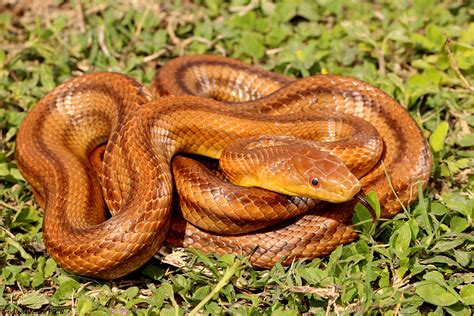How To Identify Rat Snakes In Florida? Safety Guide

Rat snakes are a common species found in Florida, and they play a crucial role in the ecosystem by controlling rodent populations. However, it's essential to identify them correctly to ensure safety, as some species can be mistaken for venomous snakes. In this article, we will provide a comprehensive guide on how to identify rat snakes in Florida and offer safety tips for encounters with these snakes.
Physical Characteristics of Rat Snakes

Rat snakes (Pantherophis alleghaniensis) are non-venomous snakes that belong to the Colubridae family. They are large, sleek snakes with a slender build, typically growing up to 6 feet in length. Rat snakes have a varied color pattern, which can range from black, brown, gray, or yellow, often with a distinctive pattern of blotches or stripes. The belly of a rat snake is usually white or yellowish, and the scales are smooth and shiny.
Key Identification Features
To identify a rat snake, look for the following key features:
- Long, slender body with a pointed snout
- Varied color pattern, including black, brown, gray, or yellow
- Distinctive pattern of blotches or stripes
- White or yellowish belly
- Smooth, shiny scales
Rat snakes are also excellent climbers, and they are often found in trees, bushes, or other elevated areas. They are constrictors, which means they kill their prey by wrapping their bodies around it and squeezing until the prey suffocates or dies from circulatory failure.
| Characteristics | Rat Snakes |
|---|---|
| Length | Up to 6 feet |
| Color Pattern | Varied, including black, brown, gray, or yellow |
| Belly Color | White or yellowish |
| Scales | Smooth, shiny |

Safety Guide for Encounters with Rat Snakes

While rat snakes are non-venomous, they can still bite and cause injury. If you encounter a rat snake in the wild, follow these safety tips:
- Keep a safe distance: Maintain a safe distance from the snake to avoid provoking it.
- Do not touch or handle: Never touch or handle a wild snake, as this can cause stress and lead to biting.
- Back away slowly: If you encounter a snake in your path, back away slowly and give it a clear path to escape.
- Seek professional help: If you need to remove a snake from your property, consider seeking professional help from a licensed snake removal service.
Rat snakes are generally not aggressive and will avoid humans if possible. However, if you are bitten by a rat snake, wash the wound with soap and water, and seek medical attention if you experience any symptoms such as pain, swelling, or difficulty breathing.
Prevention and Control Measures
To prevent encounters with rat snakes, consider the following measures:
- Seal entry points: Seal any holes or gaps in your home or building to prevent snakes from entering.
- Remove food sources: Keep your property clean, and remove any potential food sources, such as rodent attractants.
- Install snake-proof fencing: Consider installing fencing around your property to prevent snakes from entering.
What do rat snakes eat?
+Rat snakes are carnivores and primarily feed on small mammals, such as rodents, rabbits, and squirrels. They also eat birds and their eggs.
Are rat snakes venomous?
+No, rat snakes are non-venomous. They kill their prey by constricting it, wrapping their bodies around it, and squeezing until the prey suffocates or dies from circulatory failure.
How can I prevent rat snakes from entering my home?
+To prevent rat snakes from entering your home, seal any holes or gaps in your walls, floors, or ceilings. Remove any potential food sources, such as rodent attractants, and consider installing snake-proof fencing around your property.



